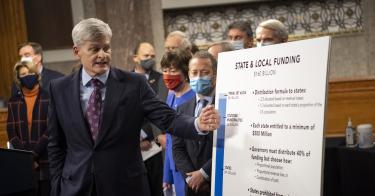It looks as though Congress won’t be including additional direct aid to state and local governments in the end-of-year COVID-19 relief package.
Congress is right to deny an additional bailout.
>>> What’s the best way for America to reopen and return to business? The National Coronavirus Recovery Commission, a project of The Heritage Foundation, assembled America’s top thinkers to figure that out. So far, it has made more than 260 recommendations. Learn more here.
Apart from the fact that it isn’t the federal government’s responsibility to cover state and local revenue shortfalls, most states don’t need the aid.
According to the most recent data, state and local combined revenues are close to unchanged compared with last year.
The federal response to the COVID-19 pandemic has already provided $360 billion to state and local governments, which comes in addition to the nearly $800 billion provided to state and local governments in the base fiscal year 2020 budget.
The next package could send an additional $100 billion or more to states to support education systems, vaccine distribution, and subsidies for mass transit.
According to the most recent data released by the Census Bureau through the end of September, state and local combined revenues increased by $20 billion, compared with the same 12-month period in 2019.
State-only revenues over the same period declined by $24 billion, or about 2.2%, because they tend to rely on more volatile taxes, such as corporate and personal income taxes, instead of property taxes.
The pandemic makes estimating and comparing revenues across years challenging, but any way you look at the most recent data, revenues are performing much better than most predictions.
For example, state and local combined revenues are only down 3.6% ($27 billion) from April through September, during the height of the economic disruptions. State-only revenues over the same six months declined by $47 billion, or about 8%.
Just looking at the most pessimistic state-only funding figures, the existing aid Congress has authorized is almost eight times the revenues states have lost in the first six months of the pandemic. The $75.5 billion in state rainy day fundsare also more than enough to make up the $47 billion of state-only revenue declines.
Some states have struggled more than others. States that rely heavily on revenue from natural resources or tourism—such as Alaska, North Dakota, and Hawaii—have faced more significant double-digit declines in revenue.
But for each of these states, federal aid to date exceeds lost revenues.
Still, some states that have been particularly hard hit by the health crisis or that have maintained overly burdensome economic restrictions may find themselves tight on cash.
In those limited cases, states have budgetary options to constrain cost growth that are normal in the private sector. A one-year pay freeze, for example, could save states about $50 billion, and suspending pension contributions and accruals (so as to not further exacerbate existing shortfalls) for one year could save up to $234 billion.
Those reforms, made in conjunction with public employee unions, could stabilize state budgets without cutting crucial services or instituting mass layoffs.
Federal subsidies set a dangerous precedent that could lead to trillions of dollars in additional federal bailouts of the most irresponsible states and localities.
For example, two of the most vocal state governments asking for additional federal bailouts, New York and Illinois, already had budget deficits of $6 billion and $1.1 billion before the pandemic hit. Their budget problems would have existed with or without the coronavirus.
Federal aid also tends to expand state budgets and make them less resilient during future crises, perpetuating problems such as systematic pension underfunding.
State bailouts do little more than temporarily redistribute local costs to federal taxpayers across all 50 states. And it certainly doesn’t make sense for the federal government to assume state and local shortfalls when the federal government already has about seven times as much debt per capita as state and local governments.
Federal aid also undermines local decision-making about the best pace for reopening society. State and local policymakers oversee decisions that affect businesses’ ability to operate, and they should assume the potential costs of new and ongoing closures of businesses and schools they impose.
States with the most restrictive economic policies are suffering from the largest business, employment, and economic losses. Federal taxpayers should not continue to subsidize state and local decisions (which often aren’t backed by data or science) to shutter businesses and ruin livelihoods.
By not providing additional state bailouts, Congress has wisely recognized that more funding is both unnecessary and counterproductive.
This piece originally appeared in The Daily Signal



